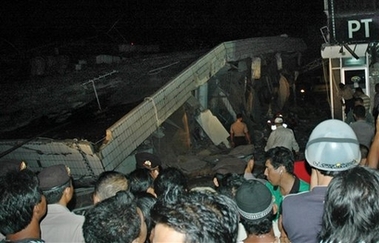Another powerful quake shakes Indonesia
Updated: 2007-09-13 16:08
Padang - A powerful earthquake shook western Indonesia for the second straight day Thursday, collapsing buildings in a coastal city and triggering tsunami alerts around the region. The latest quake was also felt in Malaysia and in Singapore where tall buildings swayed. It triggered at least one strong aftershock.
 Residents and rescuers inspect a building destroyed by earthquake in Padang, Sumatra island, Indonesia, Wednesday, Sept. 12, 2007. |
On Wednesday, a strong earthquake shook Southeast Asia, collapsing buildings, killing at least five people and injuring dozens in Indonesia. That tremor triggered a small non-destructive tsunami off the coastal city of Padang on Sumatra, the Indonesian island ravaged by the 2004 tsunami disaster. A tsunami warning was issued for wide areas of the region and nations as far away as Africa.
Thursday's magnitude-7.8 quake rattled the same area of Sumatra.
Rafael Abreu, a geologist with The US Geological Survey in Colorado, said the quake on Thursday did not appear to be an aftershock to the 8.4-magnitude temblor the day before. But the centers of both were close together.
"We are not calling it an aftershock at this point. It's fairly large itself. It seems to be a different earthquake," Abreu said.
"The quake seems to be pretty shallow," he said. "These are the quakes that can produce tsunamis."
Indonesia issued a tsunami warning, lifted it and then reissued it. A tsunami watch was also in effect for Australia.
The USGS said the new quake was centered about 125 miles from Bengkulu, a city on Sumatra. It occurred at a shallow depth of about six miles and struck at 6:49 am.
The Pacific Tsunami Warning Center in Hawaii warned Thursday's quake had the potential to generate a destructive regional tsunami along coasts within 600 miles of the epicenter. It advised authorities to take immediate action to evacuate coastal areas.
Thursday's quake caused extensive damage in Padang, a local official said.
"Many buildings collapsed after this morning's quake," Fauzi Bahar, the mayor, told El Shinta radio. "We're still trying to find out about victims.
Thousands of frightened people piled in trucks or sought shelter on high ground.
After Wednesday's quake, frightened people fled their homes and ran inland, fearing a repeat of the 2004 earthquake and tsunami off the coast of Sumatra that struck a dozen nations around the Indian Ocean. That disaster killing an estimated 230,000 people in a dozen nations, most of them in Aceh province on Sumatra.
"Everyone is running out of their houses in every direction," Wati Said reported by cell phone from Bengkulu, a town 80 miles from the quake's epicenter. "We think our neighborhood is high enough. God willing, if the water comes, it will not touch us here. ... Everyone is afraid."
One witness, Budi Darmawan, said a three-story building near his office fell.
"I saw it with my own eyes," he told El Shinta radio.
The first quake was felt in at least four countries, with tall buildings swaying in cities up to 1,200 miles away. It was followed by a series of strong aftershocks, further rattling residents.
Telephone lines and electricity were disrupted across a large swath of Indonesia, making it difficult to get information about damage and casualties.
Suhardjono, a senior official with the local meteorological agency who like most Indonesians uses only one name, said a small tsunami, perhaps 3-feet high, struck Padang about 20 minutes after the quake. The Pacific Tsunami Warning Center also reported a small wave.
But most of the damage appeared to come from the ground shaking.
Two people died when a car dealership collapsed in Padang and another was killed by a fire on the fourth floor of a damaged department store, a witness, Alfin, said by phone. Excavation machinery was being used to search the rubble for survivors, he said.
The Health Ministry said two people died in Bengkulu. The Social Affairs Department said seven had been killed in and around the town. The differing tallies could not be reconciled immediately.
At least 194 people were injured in Bengkulu, reported Amin Kurnia, a doctor who said most were being treated in a compound outside the hospital because its walls were cracked.
The undersea temblor hit around 6:10 pm at a depth of 18 miles, the US Geological Survey said.
In Indonesia's capital, Jakarta, hundreds of miles from the epicenter, office workers streamed down stairwells as tall office buildings swayed. High-rises also were affected in Malaysia, Singapore and Thailand.
Sensitive to the 2004 tsunami disaster, governments issued alerts as far away as Kenya and Tanzania in East Africa, telling people to leave beaches. People in Mombasa, Kenya, crowded into buses after hearing the warning over the radio.
Thailand's National Disaster Warning Center sent cell phone text messages alerting hundreds of officials in six southern provinces, and after the danger past broadcast a statement on television to reassure the public.
In India, officials said the tremor was not felt in the remote Andaman and Nicobar islands, some of which are just 150 miles north of the quake's epicenter. But an alert was issued and authorities were told to take precautions, said Dharam Pal, the regional relief commissioner.
Sri Lankans were told to move at least 660 feet inland.
In Australia, the tsunami warning was lifted after only small rises in the sea level were measured at Cocos Island and the Christmas Islands.
Indonesia, the world's largest archipelago, is prone to seismic upheaval due to its location on the "Ring of Fire," an arc of volcanos and fault lines encircling the Pacific Basin.
|
|
|
||
|
||
|
|
|
|